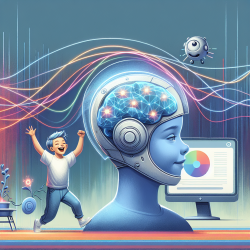Introduction
In the quest to enhance child development, the use of innovative technologies such as electroencephalography (EEG) has shown promising potential. The recent study titled "Simplified Attachable EEG Revealed Child Development Dependent Neurofeedback Brain Acute Activities in Comparison with Visual Numerical Discrimination Task and Resting" offers valuable insights into how EEG can be utilized for neurofeedback applications in education and therapy.
Understanding the Study
This research explored the use of a simplified, attachable EEG device in monitoring brain development in children. The study was conducted at a local children's event where participants engaged in a neurofeedback game. The game involved three stages: a visual discrimination task, an open-eye resting condition, and a neurofeedback task. The EEG device recorded brain wave activity, focusing on beta and theta waves, which are crucial in understanding cognitive functions and development.
Key Findings
- Age-dependent left brain lateralization of beta waves was observed during the neurofeedback stage.
- Alpha waves showed significant age-dependent changes during the open-eye resting stage.
- The study suggests that EEG can be a powerful tool for visualizing brain activity, offering potential applications in education and therapy.
Implications for Practitioners
For practitioners in speech-language pathology and related fields, the findings of this study emphasize the importance of integrating EEG-based neurofeedback into therapeutic practices. Here are some ways to implement these insights:
- Incorporate EEG in Assessments: Use EEG devices to assess neurodevelopmental progress in children, particularly those with ADHD or ASD.
- Design Engaging Neurofeedback Activities: Create interactive games or activities that utilize EEG data to provide real-time feedback, enhancing cognitive and emotional regulation.
- Collaborate with Educators: Work with teachers to integrate EEG-based tools in classrooms, supporting students with learning disorders through personalized neurofeedback interventions.
Encouraging Further Research
The study highlights the need for further research to validate these findings and explore additional applications of EEG in child development. Practitioners are encouraged to participate in or initiate studies that investigate the long-term effects of EEG-based interventions and their impact on learning and behavior.
Conclusion
The integration of EEG technology in child development holds significant promise for enhancing educational and therapeutic outcomes. By leveraging the insights from this study, practitioners can contribute to the advancement of neurofeedback applications, ultimately supporting better developmental trajectories for children.
To read the original research paper, please follow this link: Simplified Attachable EEG Revealed Child Development Dependent Neurofeedback Brain Acute Activities in Comparison with Visual Numerical Discrimination Task and Resting.










